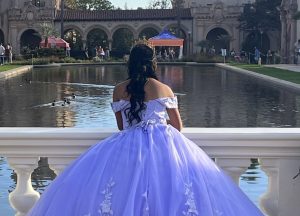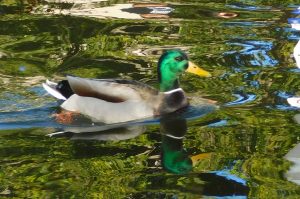

Another favorite on anyone’s Balboa Park checklist, the serene Lily Pond serves as the gateway to the Botanical Building. In nearly every season of the year, a border of colorful flowers frames the front of the pond. It may even be the most photographed spot in the park, with its classic symmetry and colorful reflections.
Little kids squeal in delight when they see the mallard ducks. Something about ducks always gets the giggles going for kids. Every once in a while, the mouth of a koi fish will poke up between the lily pads. Looking for the koi among the plants becomes a game for both kids and adults.

A few stairs up leads to a terrace rimmed by a white balustrade. There a great game of hide-and-seek of koi can entertain for quite a while. Among the hiding creatures are turtles. On the day my husband and I visited, we saw a turtle known as a pond slider in the water. An entire family of turtles live in the pond, often climbing out to sun themselves. A young couple looking over the walkway pointed out to us several koi and turtles, including a baby turtle. The tiny turtle weaved among the lily pads, its legs gracefully navigating between the lilies. The young lady pointed out a turtle sitting at the pond’s edge. The turtle’s eyes were closed, head turned up toward the sun, its left leg up in the air.
“He looks like he’s doing yoga,” she said. We all agreed, laughing with her.

The Lily Pond is a place people can feel at home any day in the park. Learning its many stories from the past, the pond becomes even more intriguing. Built in 1915 not surprisingly for the Panama-California Exposition, the “Laguna de las Flore,” as it was known then, also took an important role in both World Wars. In the First World War, the U.S. Naval Station, then located in the park, used it to teach rowing and swimming to new sailors.
During the Second World War, the U.S. Naval Hospital deepened the pond by two feet. Wounded sailors used it as a physical therapy pool. After WWII ended, children swam in the pond while adults went for bait and fly casting.

The next chapter in the Lily Pond’s life include several renovations, most notably replacing what was the wooden balustrade for the white cement one that it is now. From the balustrade you have a better view of the pastel pink white and yellow water lilies. Though they look delicate, they are hardy and strong. The koi and turtles love them and we people do too.

The Lily Pond fronting the Botanical Building with its own reflecting pond is the picture of elegance. The scene would have inspired the great artist Maxfield Parrish; he often made use of columns, pillars and urns depicting romantic scenes. Perhaps Claude Monet would have painted the interplay of the water lilies’ pastel colors with brightly colored koi swimming below, mallards drifting on the water, as on a sleepy afternoon.
Painters and photographers, even writers, have used the Lily Pond from its beginning as a place to dream and create. It will be so for generations to come, with the soon-to-reopen Botanical Building.














Discussion about this post